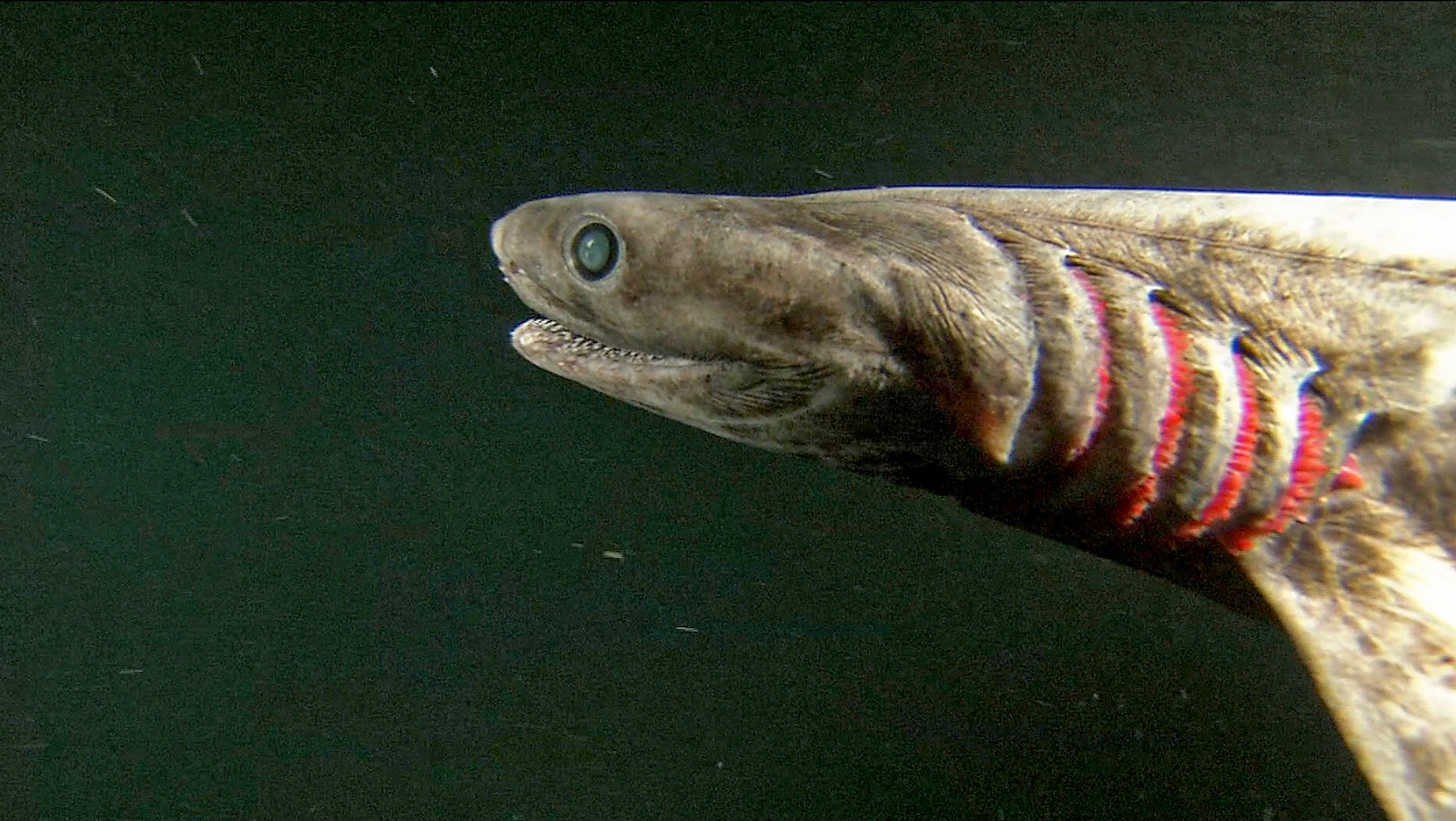The banded houndshark is a moderately slender-bodied species growing up to 1.5 m (4.9 ft) long. The snout is short, broad, and rounded; the widely separated nostrils are each preceded by a lobe of skin that does not reach the mouth. The horizontally oval eyes are placed high on the head; they are equipped with rudimentary nictitating membranes (protective third eyelids) and have prominent ridges underneath. The mouth forms a short, wide arch and bears long furrows at the corners that extend onto both jaws. Each tooth has an upright to oblique knife-like central cusp flanked by strong cusplets. There are five pairs of gill slits
El houndshark bandas es una especie moderadamente delgado de cuerpo en crecimiento de hasta 1,5 m (4,9 pies) de largo. El hocico es corto, ancho y redondeado; las fosas nasales muy separadas a cada una precedida por un lóbulo de la piel que no llega a la boca. Los ojos ovalados horizontalmente se colocan en lo alto de la cabeza; Están equipados con membranas nictitante rudimentarios (tercer párpado de protección) y tienen crestas prominentes debajo. La desembocadura forma un corto, amplio arco y lleva largos surcos en las esquinas que se extienden en ambas mandíbulas. Cada diente tiene una cúspide de cuchillo a oblicua vertical central flanqueado por pequeñas cúspides fuertes. Hay cinco pares de hendiduras branquiales
The banded houndshark is nocturnal and generally solitary, though several individuals may rest together, sometimes piled atop one another inside a cave It feeds mainly on crustaceans (including shrimps, crabs, hermit crabs, and mantis shrimps), cephalopods (including octopus), and spoon worms; polychaete worms, tunicates, peanut worms, and small, bottom-living bony fishes (including flatfishes, conger eels, herring, jacks, drums, and grunts) are occasionally consumed. Shrimp and spoon worms are important prey for sharks up to 70 cm (28 in) long; cephalopods predominate in the diets of larger sharks
El houndshark bandas es nocturna y generalmente solitarios, aunque varias personas pueden descansar juntos, a veces apilados uno encima de otro dentro de una cueva Se alimenta principalmente de crustáceos (incluyendo camarones, cangrejos, cangrejos ermitaños, y galeras), cefalópodos (pulpo incluidos), y cuchara gusanos; gusanos poliquetos, tunicados, gusanos de maní y pequeños, peces óseos viven en el fondo (incluidos los peces planos, congrios, arenques, jureles, tambores y gruñidos) en ocasiones se consumen. Camarones y cuchara gusanos son presas importantes para los tiburones de hasta 70 cm (28 pulgadas) de largo; cefalópodos predominan en la dieta de los tiburones más grandes
Mating occurs during the summer, and involves the male swimming parallel to the female and gripping her pectoral fin with his teeth; thus secured, he then twists the aft portion of his body to insert a single clasper into her cloaca for copulation. The banded houndshark is aplacental viviparous, in which the developing embryos are sustained to birth by yolk. Females bear litters of 9–26 pups after a gestation period of 9–12 months, though litters as large as 42 pups have been recorded. The newborns measure 18–20 cm (7.1–7.9 in) long. Males mature sexually at 5–6 years old, when they are 93–106 cm (37–42 in) long, and live up to 15 years. Females mature sexually at 6–7 years old, when they are 106–107 cm (42–42 in) long, and live up to 18 years
El apareamiento se produce durante el verano, y consiste en la natación masculina en paralelo a la hembra y agarrando su aleta pectoral con sus dientes; por lo tanto asegurada, luego tuerce la parte posterior de su cuerpo para insertar una sola clasper en su cloaca para la cópula. El houndshark bandas es aplacental vivíparos, en el que los embriones en desarrollo se mantienen al nacer por yema. Las hembras tienen camadas de 9-26 crías después de un período de gestación de 9 a 12 meses, aunque las camadas se han registrado tan grande como 42 cachorros. Los recién nacidos miden 18-20 cm (7.1 a 7.9 pulgadas) de largo. Los machos maduran sexualmente a los 5-6 años de edad, cuando son 93 a 106 cm (37 a 42 pulgadas) de largo, y viven hasta 15 años. Las hembras maduran sexualmente a los 6-7 años de edad, cuando son 106-107 cm (42-42 pulgadas) de largo, y viven hasta los 18 años
























